
View of Southern Guild’s booth at the 2024 edition of Investec Cape Town Art Fair.
Photo Osman Can Yerebakan for ARTnews
[ad_1]
There’s busy, and then there’s bonkers.
Sutton Foster, one of musical theater’s most celebrated performers, had already committed to starring in a City Center production of “Once Upon a Mattress,” on top of developing concert shows for Carnegie Hall and Café Carlyle, when she was approached last fall about stepping into the lead female role in the Broadway revival of “Sweeney Todd.”
She hesitated.
“Sweeney” wanted new stars in January, the same month as the “Mattress” production. She would have to simultaneously master two scores and two stagings while building the bespoke concert shows and learning to speak with a Cockney accent. And even if, as it turned out, “Sweeney” was willing to wait until her “Mattress” run ended, she’d still have to do double duty — rehearsing “Sweeney” during the day while performing “Mattress” at night.
She said yes.
On Feb. 9, she took her first bows as Mrs. Lovett, the shamelessly resourceful pie shop owner in “Sweeney Todd,” alongside Aaron Tveit, also in his first night, as the bloodthirsty barber (the show’s title character). It was just five days after she took her final bows as Princess Winnifred the Woebegone, a coarse but determined marriage candidate in “Once Upon a Mattress,” and the applause was thunderous.
So how did she do it?
Plenty of people hold down two jobs at once. There are repertory companies in which actors perform in a rotating selection of shows. There are Broadway stars who spend offstage hours filming television shows. And 40 years ago, Cynthia Nixon, while still a teenager, spent three months performing in two Broadway plays at the same time (dashing from one theater to another and back again).
But still, learning the starring roles in two vocally and physically demanding musicals at virtually the same time is a feat. And, inevitably, Foster faced hurdles. Among them: Halfway through “Mattress” rehearsals, she came down with Covid (for a third time).
In a series of interviews, Foster talked about why she agreed to the potential pileup and how she approached the work.
“I do love a challenge,” she said.
She has always revered “Sweeney Todd.” The commitment being sought was relatively short — 12 weeks. The two productions were willing to coordinate and adapt to accommodate her availability. And another factor, even for someone of her stature, was the ever-present awareness of the vagaries of theater.
“It’s an embarrassment of riches, and I’m very aware of how lucky I am,” Foster said. “I get these opportunities to play roles like this, and I don’t know how long that will be, you know? I know how rare it is. And I also know it’s fleeting.”
She decided to study “Sweeney” first, even though she was starting performances in it last, because of the limited time between shows. “The score of ‘Sweeney’ is essentially an opera,” she said. “It’s so complex, and one of the hardest scores I’ve ever had to learn.”
So she would spend as much time as possible on “Sweeney” in November and December with the goal of being able to run through that show, without an audience, by early January; then she would set “Sweeney” aside to learn “Mattress.” Once “Mattress” was up and running in late January, she would simultaneously resume rehearsing “Sweeney.” The two-week “Mattress” run would end on Feb. 4, which would give her a little less than a week to finish preparing for “Sweeney.”
“To me it’s clear that a normal human could not possibly do that,” said Lear deBessonet, who directed Foster in “Mattress.” “It’s completely epic.”
Her time was further constrained by the concerts. She needed to pick and learn the songs and patter for the November Carnegie Hall show, which she was developing with a fellow Broadway star, Kelli O’Hara, as a homage to Julie Andrews and Carol Burnett’s 1962 Carnegie concert. And then she had to create a new holiday show for a seven-night December engagement at the Café Carlyle.
“It was major compartmentalizing in my brain,” she said.
Foster, 48, has been a darling of Broadway since 2002, when she broke through, and won her first Tony Award, as a tap-dancing, husband-hunting flapper in “Thoroughly Modern Millie.” Her performances are characterized by high energy, irrepressible spirit, and go-for-broke physical comedy. She can sing (“the voice of a trumpet,” this paper once wrote), she can dance (“She’s the Top,” read a headline in Dance Magazine), and she can hold the stage.
“She has that thing you can’t teach,” said Thomas Kail, the “Sweeney” director. “As they say in ‘Gypsy,’ ‘You either got it, or you ain’t,’ and she’s got it.”
Over the years, Foster has performed in a dozen Broadway musicals, starring as the nightclub singer Reno Sweeney in “Anything Goes,” the ogress Fiona in “Shrek,” a disfigured woman seeking faith healing in “Violet,” and, most recently, as Marian, the librarian, in “The Music Man.” She has been nominated for Tony Awards seven times, and has won twice. She took a seven-year break from Broadway while appearing in the television series “Younger”; some fans also know her for the short-lived television drama “Bunheads.”
The “Mattress” and “Sweeney” roles lead with comedy, and Foster knows how to land a laugh. She’s also uninhibited — both characters, at least in her renderings, involve spitting up food onstage. “I guess it’s now my thing,” she said.
But the shows are also quite different, tonally and vocally.
“Once Upon a Mattress,” adapted from “The Princess and the Pea” and featuring music by Mary Rodgers, is built for a belter — Foster’s sweet spot — and calls for a madcap performance by the leading lady, culminating in a virtuosic display of squirming as the princess finds herself unable to fall asleep. “Sweeney Todd,” with a score by Stephen Sondheim, is more complex — tongue-twisting lyrics and unexpected notes — and, given its gruesome plot involving both homicide and cannibalism, much darker. Both characters are looking to upgrade their circumstances, but whereas Winnifred is blithely confident, Lovett is daffy and desperate.
The roles require a very different sound. “If I were to talk about it technically,” Foster said, Lovett “sits right on my break” — the place where the parts of her singing range meet. “So it’s constantly swapping back and forth, between my chest voice, my head voice, my mixed, and all in there and it’s like constantly navigating, and negotiating. It fits the character.” Winnifred sits “lower and brassier and shinier,” she added, but that feels right too. “It fits the character that she would be WAAH!”
Her first task was dialect. Foster, who spent her early childhood in Georgia, has occasionally performed with a Southern accent, but Lovett’s Cockney accent was new to her, so she began working with a dialect coach, learning to open her vowels and drop some of her consonants. “I was really nervous — afraid to make a sound, thinking, ‘I’m going to offend every British person,’” she said. At one point, she took her daughter to see “Wonka,” and found herself staring at Olivia Colman’s mouth, trying to learn from the English actress’s facial movements. “At first it was so technical,” Foster said. “I couldn’t get past the dialect to get to the words.”
At the same time, she began studying the score. Alex Lacamoire, the show’s musical supervisor, would play the notes she needed to sing; she would record parts of their sessions. “I listen over and over,” she said, “so I can nail it into my brain and let it seep into my bones.”
The “Sweeney” revival began a year ago, with Josh Groban and Annaleigh Ashford in the starring roles, and is a hit; after three months with Foster and Tveit, the show is expected to end its run. Foster had seen the revival twice, but opted not to listen to cast recordings or watch the movie as she prepared to join the cast, saying “I’m afraid of getting either intimidated or someone else’s interpretation stuck in my head.”
Once the Carlyle concerts were behind her, she began rehearsing with Tveit. Other than a bit of time off for the holidays, they worked steadily through December, so that by Jan. 5 they could do a so-called put-in rehearsal — a run-through of the show with full company and full orchestra, but only the new members of the cast in costume. “I was really proud of myself that I was able to get through the show, and I was really grateful that I wasn’t going into the show that night,” Foster said. “I wasn’t like, ‘I’m never going to be able to do this.’ It was more, ‘I’ve done it, and I have so much more I want to figure out.’”
But that figuring out would have to wait.
“I had to let it go,” she said. “It just had to be put on the back burner, and I made ‘Mattress’ my focus.”
“Mattress” was being staged as part of City Center’s Encores! series, which presents short-run productions of classic musicals, and has a limited rehearsal process. Foster knew none of the songs when she arrived, so she spent two days huddled with that show’s creative team before joining the rest of the cast.
“It was a little scary, in the sense of, is my brain going to be able to handle this? Do I have enough juice left in the tank, even creatively? Will I crash and burn?” she said. “But that’s also part of taking on any challenge. Parts of me are really excited, parts of me are calm, parts of me are nervous. It’s all the things.”
She had learned half the show, and made it through half the rehearsal days — when she tested positive for Covid, forcing her to take several days off. And when she returned she had to rehearse in a mask, even while singing.
“I was determined to keep going,” she said.
“Mattress” opened Jan. 24 to enthusiastic crowds and strong reviews. “Foster’s glee in taking possession of the stage,” the critic Elisabeth Vincentelli wrote in The New York Times, “creates an all-encompassing manic energy that both the audience and her scene partners feed off.”
With “Mattress” on its feet, Foster resumed rehearsing “Sweeney,” learning Lovett during the day while performing as Winnifred at night.
“I was witnessing her flip back and forth like she was changing channels on a TV,” said Mary-Mitchell Campbell, the “Mattress” musical director. “It was insane but phenomenal.”
It was also painful. “‘Mattress’ was way more physical than I was anticipating,” Foster said. “I’d go to sleep and my hip would hurt, my shoulder, my back, my foot. Winnifred beat me up.”
“Sweeney” was no joke either — she was developing physical antics that included massaging Tveit’s chest with her feet while she sang upside down.
The pressures on her body are harder than they might have once been. Foster thinks of performers as athletes — she is hyper-focused on sleep and hydration; she naps and meditates and meets with a vocal coach and a life coach; she teaches dance cardio and she crafts to stay sane. Age, she said, has been a mixed blessing.
“Physically, it gets harder,” she said. “But I’m also a little bit wiser, and I have more ability to ask for help — to figure out what I need to protect myself, and to modify. I still get nervous, but I have more tools to handle it than when I was younger. And it’s easier because I have so many things in my life” — including her 6-year-old daughter — “that are just as important as what I do for a living.”
Ten days into the “Mattress” run, she arrived at the Lunt-Fontanne Theater for an early afternoon “Sweeney” rehearsal and immediately began scarfing down a peanut butter sandwich, saying “I need some calories” as she ate her first meal of the day.
As she ran through a scene with John Rapson, playing the Beadle, she missed a few lines, and looked in the wrong direction for an entrance by Tveit. “Did I say most of the words right?” she asked of no one in particular. Kail, the director, clambered onto the stage and provided some suggestions about how to think about her character’s motivation. They ran the scene again. “Better?” she asked, wiping her brow.
During breaks, she drank from her daily 32-ounce blend of greens, electrolytes and collagen, glanced at her phone, told her castmates a story about her daughter, and marveled at the hulking industrial set. She was relentlessly upbeat, at times snorting with laughter. Back onstage, as she worked through scene after scene, there were minor stumbles — at one point, she collided with an ensemble member while exiting the stage — but also confirmation of her comedic choices, like wiping her nose with pie dough, which would develop into a crowd pleaser.
She said parts of “Sweeney” had slipped away during “Mattress,” but were still there, somewhere. “It’s like in that dark corner of my brain,” she said.
When she returned to City Center in Midtown for a “Mattress” performance, among those in the audience was Tveit, marveling at the Winnifred-Lovett shuffle. “We had run ‘Sweeney Todd’ in the afternoon, and I went home and had dinner and somehow saw her two hours later in ‘Mattress,’ and just thought in my brain, ‘What is happening?!’” he said. “I couldn’t imagine doing that myself.”
For Foster, there was one more weekend of “Mattress” performances, and then a few days of full “Sweeney” focus before facing an audience. On the day she and Tveit were to finally unveil their performances, she arrived early for a photo shoot, gathered in a circle with her new cast, obsessively ran through the wordplay-dense Act One finale, “A Little Priest” (“I’m the crazy lady talking to herself”), and, while putting on her wig and makeup, had a video call with her daughter, who was eating a lasagna Foster had made that morning.
The crowd was electric — thrilled to see Tveit, thrilled to see Foster, thrilled to see Joe Locke, the “Heartstopper” star who had joined the cast 10 days earlier. Foster wasn’t sure how to process the raucous enthusiasm — “there’s a little bit of disassociation that happens,” she said — but by the next morning, about 12 hours after leaving the theater, she finally took a breath.
“I still feel a little dazed — really tired, really proud, really relieved,” she said. “Yes, I flubbed a couple of lyrics, but my greatest fear is that I will get off and I won’t be able to get back on — that it will all fall apart — so what I was grateful for is that I got right back on, and I thought, that’s such a good find, for my own peace of mind. Remember that: I’m not going to derail the train.”
That first performance, she said, was only another beginning. She has three months now to grow in the role, and then, she hopes, a vacation, followed by a season of concertizing.
“I like to think of myself not only as an actor, but also a detective, and as I’m playing the role I’m also paying attention to what’s working, and what isn’t,” she said. “You get an opportunity every day to keep discovering. And I don’t think you ever stop.”
[ad_2]
Source link
[ad_1]
“Let’s keep in touch,” reads an inscription on a pink ceramic vessel by Cape Town–based sculptor Githan Coopoo that has been placed near the entrance to the Investec Cape Town Art Fair. Coopoo’s optimistic sentiment was palpable in the Cape Town International Convention Centre during the VIP preview on Thursday for the fair’s 11th edition, which includes more than 100 exhibitors from 24 countries. The energy had actually started a few days earlier as the Mother City’s annual art week kicked off with exhibitions, performances, and talks across the breezy ocean town.
The vernissage saw a crowd of around 5,000 attendees which included largely local collectors taking an early look at 400 works mainly by African artists and artists its diasporas. Key local market heavyweights like Goodman Gallery, Stevenson, SMAC Gallery, WHATIFTHEWORLD, and Southern Guild, which will open a Los Angeles outpost later this month, showed alongside Kenya’s Circle Art, Galerie Cécile Fakhoury from Côte d’Ivoire, A.Gorgi from Tunisia, Botswana-based Ora Loapi, and Borna Soglo Gallery from Benin. Several Italian exhibitors, such as Galleria Giovanni Bonelli, Galleria Anna Marra and Shazar Gallery, were also on hand, likely due to the fair’s Milanese owner company Fiera Milano.
Laura Vincenti, the fair’s director, described the last decade as “a learning curve” to ARTnews. In that time, she has focused on bringing “galleries with content that communicates with the local scene,” she said. “I have learned that not all galleries are prepared to show in Cape Town.”
In addition to the main gallery section, Investec also includes eight curated sections like Generations, which is new to the fair this year. (Exhibitors can participate in multiple sections.) Organized by Natasha Becker and Amogelang Maledu, Generations pairs young artists with established names to show parallels between artists’ work across decades. The section’s cash prize of $80,000 South African Rand (around $4,200) was awarded to Johannesburg-based painter Boemo Diale, who exhibited with South African gallery Kalashnikovv Gallery.
“The goal is to create fresh perspective on historical figures through the lens of contemporary artists who are in dialogue with the past,” Becker told ARTnews.
One example is placing SMAC Gallery’s presentation of Bonolo Kavula’s ephemeral geometric cutouts of shweshwe cloth adjacent to the Melrose Gallery’s booth dedicated to color-bursting paintings and sculptures by Esther Mahlangu, the grand dame of South Africa’s art scene whose career survey at the Iziko South African National Gallery also opened this week.

View of Southern Guild’s booth at the 2024 edition of Investec Cape Town Art Fair.
Photo Osman Can Yerebakan for ARTnews
Nearby, the vibrantly corporal paintings by Terence Maluleke at the Southern Guild’s booth flirt with Riaan Bolt Antiques’s group presentation dedicated to early Apartheid-era tapestry and pottery which has largely remained in European collections. Southern Guild sold all seven of Maluleke paintings which range between $5,000 and $8,600 before the end of the VIP day. “The response was extremely positive,” said Southern Guild director Jana Terblanche of the gallery’s multiple presentations at the fair, which also sales of four Kamyar Bineshtarigh paintings for around $20,000 each and a timber-and-acrylic sculpture by Dominique Zinkpè for $24,000.
In the main section, Goodman Gallery exhibited a selection of roster artists including international powerhouses like William Kentridge and Yinka Shonibare alongside Kudzanai Chiurai and Gabrielle Goliath, who will both feature in this year’s Venice Biennale. On par with the gallery’s intergenerational presentation, prices for works sold on the first day ranged broadly from $12,000 to $275,000.

View of Goodman Gallery’s booth at the 2024 edition of Investec Cape Town Art Fair.
Courtesy Goodman Gallery
Goodman is also showing in a section of the fair called “Tomorrows/Today,” which speculates on “tomorrow’s leading names,” per the fair’s description. The gallery introduces the subtly documentarian photographs of Lindokuhle Sobekwa ahead of his first institutional show at the Johannesburg Art Gallery this September.
“Sobekwa’s imagery has a delicate yet powerful quality that draws viewers into the stories he articulates. He is definitely an artist we are excited to support,” said Olivia Leahy, Goodman Gallery’s head of curatorial.
Stevenson, another established South African gallery, had in its booth a kitchen photograph by South African Pieter Hugo; a nocturnal-hued, large-scale abstraction, titled The Abundance of life (2023), by New Zealand-based Nigerian painter Ruth Iga; and Penny Siopis’s Mercy (2007), a striking drawing of a figure that leaps out of the frame into a plastic chain to spell the work’s title.
The scene-stealer in WHATIFTHEWORLD’s grouping was Chris Soal’s intricately built toothpick and concrete sculpture, Inferno, which sold for $17,100. Pierre Vermeulen’s mixed-media linen painting of faux gold leaf and sweat, Somewhere I have never travelled, gladly beyond, found a collector for $13,400.

View of EBONY/CURATED’s booth at the 2024 edition of Investec Cape Town Art Fair.
Photo Osman Can Yerebakan for ARTnews
Another standout at the fair comes in the Solo section, where EBONY/CURATED has a presentation dedicated to local painter Anico Mostert, who makes dreamlike oil on canvases with powdery hues. His 2023 work, From View to View, sold for $4,200 on the first day.
One of the fair’s section with the abundant promise of discovery is ALT, which provides a platform for non-traditional commercial formats, such as curatorial collectives, nomadic spaces, advisory services, and online galleries. South African curator and adviser Anelisa Mangcu’s four-year old initiative Under The Aegis builds a corporal tie between Dutch-Ghanian photographer Casper Kofi’s dramatically lit images of landscapes and men, alongside Buqaqawuli Thamani Nobakad’s female protagonists painted with acrylic on lace and paper.
Church Projects’s gold color-painted booth drew in visitors to the moody prints of Durban-based photographer Alka Dass, showing men that he adorns with gentle punctures of red threads and beads. Borna Soglo Gallery displayed London-based artist Tamibé Bourdanné’s photographs of Bubi Ogisi performing in Benin for a personal exploration of African masquerades that are accompanied by the plush toys donned by Ogisi in the booth’s corner.
The Investec Cape Town Art Fair continues into the weekend, with stand-out programming like a two performances by Cape Town–based artist Thania Petersen at the Bo Kaap Museum on Saturday evening, accompanied by jazz musician Hilton Schilder, Afrikaaps rapper, poet Jitsvinger, and a handful of dancers.
[ad_2]
Source link
[ad_1]
Two brothers, Alex and Henri, grew up in Antwerp, Belgium, surrounded by beauty and creativity that developed into a shared passion for art and design. Inspired by the success that their parents experienced in the interior design and vintage furniture industries, the duo decided to make a leap of their own. Frero is their brand, which puts their unique vision and individual strengths toward the same goal. Alex brings the creative vision to the table, while Henri provides the commercial expertise to realize those ideas.
Frero’s first collection, Tala Asa, is a series of five light sculptures brought to life with the help of reused stone and minerals bonded using a resin and finished with plaster paint. Inspired by the earth itself, each design uses light elements to focus on the shadow play of each lamp’s negative space. Handmade in their North Carolina design studio, each piece allows the materials to guide the process of their own creation, taking on shapes and forms that are truly unique. Five naturally occurring colors are available to choose from: Bone, Sienna, Oliva, Terra, and Lava.
Suma is simple yet elegant, with a silhouette informed by geology. The design was created to blend in with a variety of surroundings, making this lamp one of the most versatile in the Tala Asa collection.
Each lighting object within Tala Asa is an art object on its own, as is the Fuca lamp. Designed in Antwerp and handcrafted in North Carolina, this object celebrates squareness through more play with light.
The three openings on each side of the Anta lamp symbolize their family bond. It also represents the unity, creativity, and individuality it takes to work with one another to bring a project larger than any one of them together.
Perhaps the most sophisticated lamp of the collection, Sunda is a statuesque design borrowing from the structure of tectonic plates. More specifically, “an oblique subduction transition zone” that’s located between the Australian Plate and the Southeast Asian Plate.
Coco’s design is focused on capturing a natural equilibrium between the visually stacked elements of the lamp. Frero gave it the name “Coco” for the repetitive enunciation of the syllables, resembling its balanced silhouette.
To learn more about the Tala Asa collection, visit frerocollective.com.
[ad_2]
Source link
[ad_1]
Kathleen McDonnell’s western New York home is surrounded by evergreens, which often serve as subjects for her paintings. “Living in the woods has helped me build a connection with the landscape,” she says. “While the familiar subjects are important, the mood of these landscapes touches me more deeply. It’s not just a rock, tree, or wildflower, but the way these parts are connected with the whole landscape. Through color and light, I try to capture the spirit, strength, beauty, and power that exist in the landscape—to capture the mood and not just the place.”
Here, McDonnell demonstrates her ability to employ color and light effectively to instill two distinct moods in the same scene—depicted in both summer and winter.
SUMMER: Morning Walk is a pastel painting that I completed using a full-color palette. The light was just beginning to fall across the treetops in this summer morning scene.
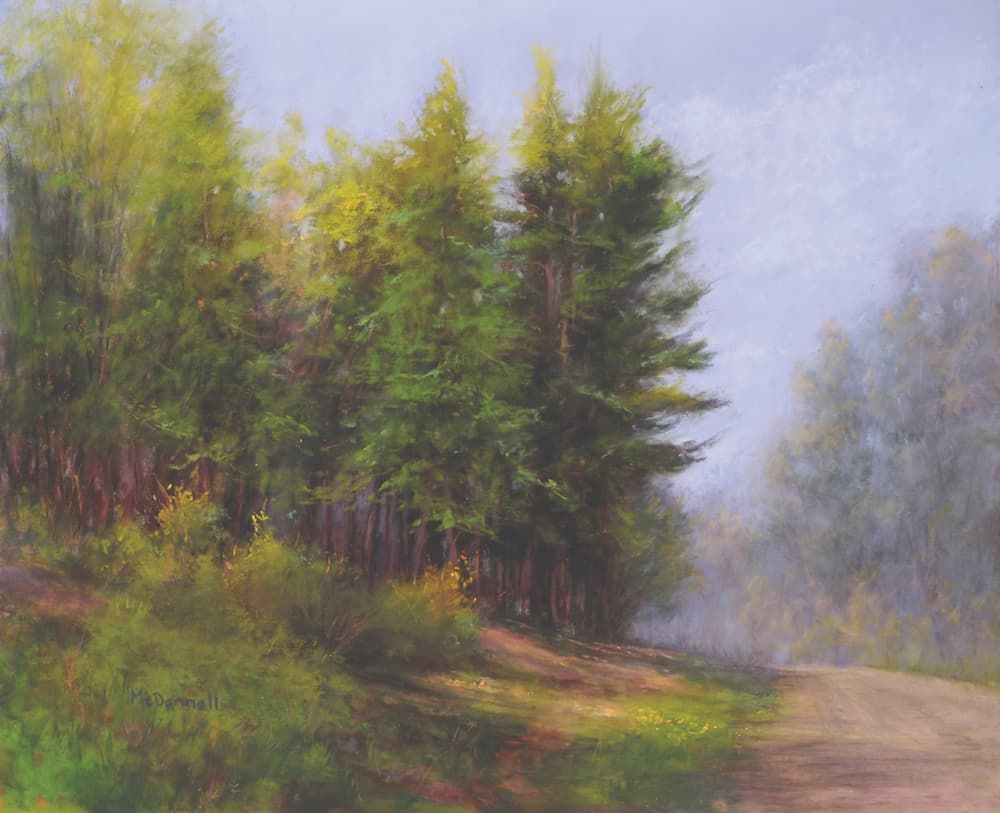
WINTER: I decided to create a pastel of the same view as that seen in Morning Walk based on photo references taken during one of my winter snowshoe outings. The trails in the park were snow-covered, and the foggy, misty atmosphere made me feel as though I was floating along the path.


Value Studies: All my pastels begin with a value study in black, white, and gray. For this winter scene, I developed several compositions and then chose a horizontal view similar to that of Morning Walk.

Pastel Application: While referring to the value study, I began my pastel drawing on a sanded pastel board dry-mounted to conservation board. I then applied a black hard pastel in the areas with the darkest values. Using Turpenoid on a stiff bristle brush, I liquefied the hard pastel to lighten some of the dark values. I completed the lighter values by dabbing with the Turpenoid-loaded brush and applying a gray hard pastel.
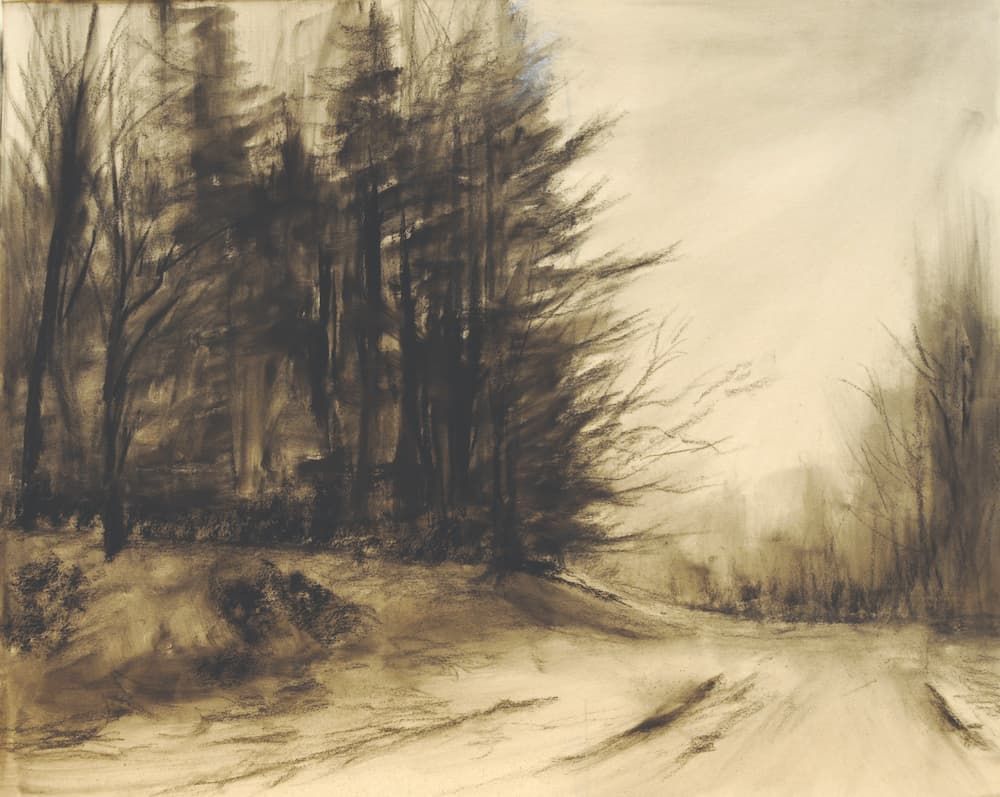
Final Adjustments: Because I’d completed Morning Walk in this same location, I was familiar with the shapes beneath the snow-covered road and of the foliage. With fewer than 15 warm and cool grays and a limited use of a cool, muted green, I completed A Winter Walk. Warm neutrals in the foreground provide a further touch of color. Even though the location and shapes are much the same as those in Morning Walk, the conveyed mood is completely different.

Surface: UART 400 paper, dry-mounted on conservation board
Pastels: Cretacolor and Prismacolor NuPastel to start—then Unison, Great American, Schmincke, and Blue Earth added
Other: Weber Odorless Turpenoid applied with a stiff bristle brush (Grumbacher No. 12 flat) to lighten areas of dark-value hard pastel; No. 1 Guerrilla Painter oil-painting brush to lift pastel for corrections; single-edged razor blade to sharpen pastels
Kathleen McDonnell is a Signature Member of the Pastel Society of America, the Pastel Painters Society of Cape Cod, the Pastel Society of the West Coast, and an artist member of the Buffalo Society of Artists. She has received local and national awards, including the Award of Distinction from the Midwest Pastel Society; Merit Awards from the Pastel Painters Society of Cape Cod; the Scholarship Award and the Elizabeth Mowry Award from the Pastel Society of the West Coast; and the B&V Griffuni Purchase Award from the Pastel Society of America.
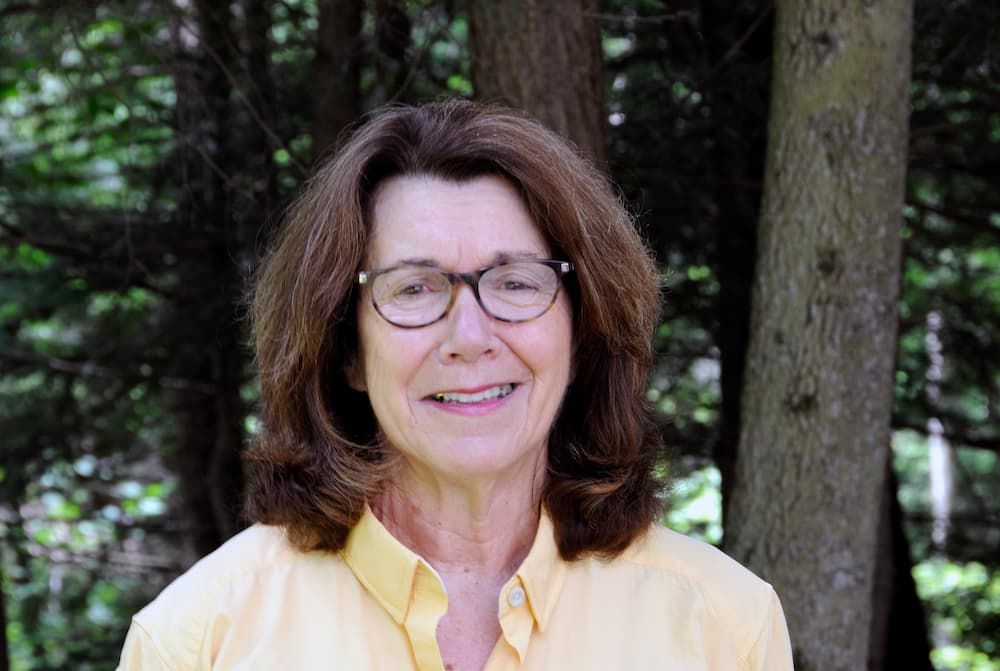
Michael Chesley Johnson is an artist, workshop instructor, and author of the book, Beautiful Landscape Painting Outdoors: Mastering Plein Air.
[ad_2]
Source link
[ad_1]
Valentine’s Day ought to bring out the best in us, and that was very much on the mind of Josh Basseches, the director and chief executive of the Royal Ontario Museum (ROM), as he addressed a press gathering in Toronto on the morning of 14 February to announce the ROM’s latest initiative—a renovation project the institution has named OpenROM, which will tweak the architect Daniel Libeskind's 2008 expansion of the museum.
“My wife reminded me that this was Valentine’s Day,” Basseches said to launch the event, which attracted a sizeable crowd, not a seat left empty. “We will treat this as a Valentine’s gift to the city, the province and beyond. OpenROM is about the very future of the museum.”
And that future seems bright indeed, highlighted by the renovation of the institution’s ground floor bathed in natural light and an additional 6,000 sq. ft of gallery space. Work is set to begin shortly, with 2027 as the target date for completion. The museum will remain open during that time.
Free access to its main floor, which has proved a boon in recent years, will continue after construction is done. It will host performances and programmes while becoming what Basseches called “a humming public plaza” and “a cultural and civic hub”.
The Bloor Street entrance of the venerable building—which dates to March 1914, scant months before the beginning of the First World War—is also being redesigned, making for what Basseches calls “an even more welcoming and accessible space. It’s the beginning of the next great chapter for the ROM.”
Rendering of the Royal Ontario Museum's OpenROM project Courtesy the Royal Ontario Museum
All of this is made possible by a C$50m ($37m) donation from the Hennick Family Foundation—the single largest cash gift in the ROM’s history. Jay and Barbara Hennick attended the press conference, with the former labelling the ROM “one of the world’s great museums”, saying of its collection, “There are things that will blow you away.” The ROM is hardly short on material to exhibit, as there are some 13 million objects in its collection—almost the same number as the population of Ontario. But Hennick feels the museum has been lagging, having not yet realised its full potential. He believes his gift will help immeasurably in that regard. Speaking of OpenROM, he said, “It is going to re-engage the visitor experience.”
Siamak Hariri, of the award-winning Toronto-based firm Hariri Pontarini Architects, which is handling the design, also spoke at the event. “Architecture gives form to aspiration,” he said. “We’re going to re-introduce the ROM to Toronto with a design that, in effect, turns the museum inside out. We’re going to bring daylight and views deep inside and create new connections with Bloor Street.” But as is the case with any huge undertaking, the project is not without its challenges, Hariri admitted: “The waters have been choppy.”
Also in attendance was Neil Lumsden, Ontario’s minister of tourism, culture and sport and a one-time star footballer. He used the word “fabulous” more than once, wrapping up by saying, “It’s a huge tourist attraction that’s going to get even better.”
Like all institutions, the ROM suffered early in the Covid-19 pandemic, but it seems on the rebound, with better days still to come.
[ad_2]
Source link
[ad_1]
Philosopher Pliny the Elder is known for texts like Natural History (77–79 C.E.) and for his role as a naval and army commander in the Roman Empire. Now, researchers have discovered the remains of a sizable Roman villa that may have been associated with the great polymath.
The complex includes 10 large rooms, from various phases of construction, marked by a distinctive form of Roman brickwork known as cubilia, which uses diamond-shaped bricks. Experts say that the villa may have been more than 300 feet long. The Superintendency of Archaeology, Fine Arts, and Landscape for the Naples Metropolitan Area (SABAP) said the latest discovery was of “exceptional significance.”
Remains of the villa in Miseno. Photo: Soprintendenza Archeologia.
Experts believe the villa to have been erected in the first century C.E. It was uncovered during an urban renewal project in Bacoli, near the Bay of Naples, on a site previously occupied by an illegal beachside development called Lido Piranha, which the SABAP described in a press release as an “unauthorized eco-monster” that degraded the area, which is of considerable archaeological significance.
The site is near Punta Saparella, on the coast of Cape Miseno, at the northwest edge of the Bay of Naples. Also at the site was a significant Roman port. Pliny was in charge of the naval fleet at the time of his death. He was asphyxiated as he tried to stage a rescue operation during the eruption of Mount Vesuvius, which also destroyed the nearby city of Pompeii.
The site of the villa would have provided a sweeping view of the surrounding coastline and the gulf, making it an ideal home for the naval prefect.
More Trending Stories:
A Case for Enjoying ‘The Curse,’ Showtime’s Absurdist Take on Art and Media
Artist Ryan Trecartin Built His Career on the Internet. Now, He’s Decided It’s Pretty Boring
I Make Art With A.I. Here’s Why All Artists Need to Stop Worrying and Embrace the Technology
Sotheby’s Exec Paints an Ugly Picture of Yves Bouvier’s Deceptions in Ongoing Rybolovlev Trial
Loie Hollowell’s New Move From Abstraction to Realism Is Not a One-Way Journey
Follow Artnet News on Facebook:
Want to stay ahead of the art world? Subscribe to our newsletter to get the breaking news, eye-opening interviews, and incisive critical takes that drive the conversation forward.
[ad_2]
Source link
[ad_1]
Dating shows have become a bit redundant as of late with similar concepts on separate streaming channels, but Peacock has something fresh and bingeworthy that’s serving up drama, sex and new propositions.
“Couple To Throuple” follows “four curious couples through the world of polyamory as they experiment with bringing a third partner into their relationship.” Access Hollywood correspondent Scott Evans and sex and relationship expert Shamrya Howard are hosting the fiery series, assisting four couples along the process of learning if the polyamorous lifestyle is for them.
HuffPost spoke to Evans and Howard about the series, their own interests and expertise on polyamory and what they hope audiences learn from the show.
We see the contestants explore the throuple life. Is throuple life for you?
Scott Evans: I wanted to do this show because I felt like so many of my friends discuss open relationship dynamics and the “throupledome.” I won’t tell you all the details of what goes on in our group chat, but we’re discussing a lot of the things and themes we discuss on the show. The idea that there’s an experience of a relationship dynamic that doesn’t limit or only include two people is something we’re seeing a lot more these days. I’ve had my own experiences with nonmonogamy, and I was just waiting to see where we can inherently see this queer experience in a dating show. Also, why does it have to be one girl looking for a guy or vice versa? It was very clear we all have been ready to see this television.
Which couple do you think strengthened their relationship the most during the season, and who do you think needs a bit more work and why?
Evans: I think everyone who participated in this experience were asking questions to themselves: Could they be stronger as a throuple? And they are all challenged in many meaningful ways the moment they step on the resort. Most were surprised it would be an emotional experience as it began with the physical experience, but we quickly moved away from the superficial physical nature of what a dynamic might be for someone into the emotional because I think their real intentions were to find a third partner and find a way to welcome another person into their relationship.
I was fascinated by our same-sex couple in Rehman Bhatti and Ashmal Ali. They’re there to have this experience together, with one identifying as bisexual and one as don’t-knock-it-till-you-try-it sexual. [Laughs] They challenged themselves to step outside of their normal behavior and challenged their potential partners to step up and make them feel comfortable. Cameras helped people feel safe and not do things in secret — we are all a part of this together. I won’t tell you the surprises, but with every single one of our couples, we were all gagged.
Can you share the three major keys to having a healthy and sustainable throuple-ship, and can you break down the difference between an open relationship and a polyamorous relationship?
Shamyra Howard: First, let’s talk about having a great throuple relationship. You have to understand that you’re going to be in a relationship — meaning you have to be willing and open to your values as well as your partner(s) values. So being open to that is to be open to understanding that you have to come up with boundaries and agreements; you have to leave the rules out of it, because that can damage the structure of it because a person has no agency in setting rules or rule-setting.
You have to understand being in a polyamorous or a nonmonogamous relationship is going to require your time, effort and your sex — being able to figure out what time allocation looks like is going to take some good organization skills and social communication. Communication is always No. 1 — figuring out sexual preferences is going to take you using your mouth and opening up about what your sexual desires are. Understanding your boundaries is second — setting those boundaries and honoring them. Polyamory means being in multiple relationships simultaneously. Ethically, everyone involved understands and agrees what is happening. It is a consensual arrangement and understanding the risks, but also being able to get out of it at any time. Open relationships are another form of nonmonogamy; they agree to have more casual and sexually fluid, diverse relationships.
How do you think this series will open people’s minds to the idea of a throuple, and what are some misconceptions this show is trying to dismantle?
Howard: It will open up the misconceptions that polyamory isn’t real or people who are saying they happen to just be doing it for the sex of it all. When you see the series, you’ll see these are real relationship dynamics that have all of the elements of any other relationship, and some more because you’re dealing with extra people. There’s a lot of education that goes into having a successful throuple or for the people involved in polyamorous relationships.
One of the couples discusses queer dating and how there’s a lot of cheating, among other issues, that tamper the dating pool, even as far as being hesitant to talk to a guy who said he’s from LA. Can you share your experience and possible personal qualms about the queer dating circuit?
Evans: That’s a very great question because the expectation is that folks in LA are grimy, and it is every man for himself and that no one is necessarily honest or truly authentic in the dating scene. I think while that can be widely true for some, there are beautiful human beings who are open and ready to have meaningful connections with one another. For me, I had to be willing to reframe and change how I was showing up to situations, in order for me to change what I was getting from situations. I found that there are many viable options, many viable people who are willing and interested and prepared to be in a meaningful relationship in Los Angeles, whether they are men, women or identify as something altogether different.
I’ve had my own experiences in nonmonogamy, which is why I was so excited about this show, because we don’t really see those experiences on television. I wanted to see something that was inherently queer and reflective of the times and the trends that we’re seeing, but also the real significant shifts in how we organize relationships. I wanted to see something like that on television.
“Couple To Throuple” airs on Peacock with episodes released weekly on Thursdays.
[ad_2]
Source link
[ad_1]
National Geographic’s “Genius” series returned for its fourth season earlier this month with “Genius: MLK/X.” The season explores the lives of Martin Luther King Jr. and Malcolm X through their “formative years, where they were molded by strong fathers and traumatic injustices, to their rich, parallel stories as they shaped their identities and became the change they wished to see in the world,” according to a series synopsis.
Starring Kelvin Harrison Jr. and Aaron Pierre as King and X, respectively, the eight-episode series explores the civil rights icons as more than the political figures we love and respect.
Audiences will see two young boys who struggled with mental health grow up into powerful and complex men fighting for equality in America. The series provides layered episodes and covers several moments of the icons’ personal lives: X’s humble beginnings and his journey to prison before rising as a minister in the Nation of Islam, and King surviving a suicide attempt at a young age to be a preacher like his father before becoming a leader at the forefront of the civil rights movement.
The series also weaves in their love stories and positions their respective wives, Betty Shabazz (Jayme Lawson) and Coretta Scott King (Weruche Opia), as influential figures in their own right.
“One of the beautiful parts of playing [King] is watching him face adversity and conflict with so much love and grace for himself and the people,” Harrison told HuffPost at the Los Angeles premiere of the series, which was held at the Samuel Goldwyn Theater late last month. “I believe we’re celebrating him because of his choices, and I strive to make better choices and have more faith in myself.”
Richard DuCree via National Geographic/
Harrison began to get a bit emotional as he reflected on being a part of the new season, recalling his journey to fame. Harrison has also starred in movies such as “Chevalier,” “Waves” and “Luce.”
“It’s been a dream — no pun intended,” Harrison said. “When you’re a kid in school in New Orleans in a small city, in the South specifically, and you’re faced with internalized racism and you’re also watching Dr. King, this beacon of light who rose above it all — it’s mind-blowing to think one day you’ll be able to portray somebody like that.”
Though Pierre was raised in London, he shared how he was “very fortunate” to have known about X before portraying him due to his parents.
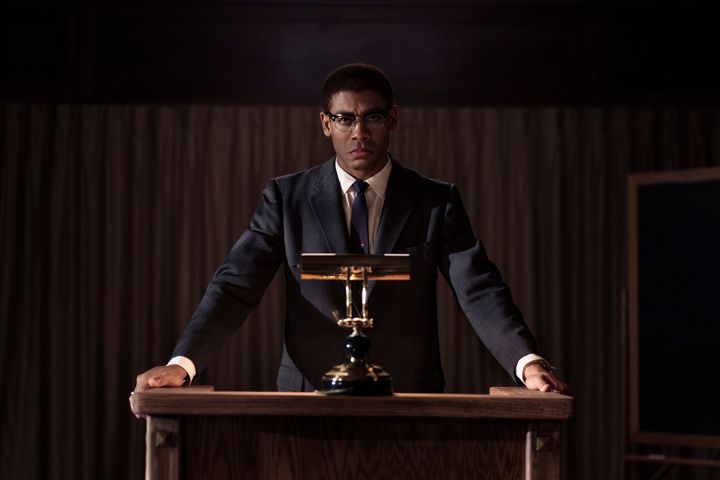
Richard DuCree via National Geographic
“My parents educated me about Malcolm X and his importance and legacy, which I’m grateful and lucky for,” Pierre, whose recent credits include “Brother” and “The Underground Railroad,” told HuffPost.
“From there, I began reading his autobiography, Betty Shabazz’s book and Peniel Joseph’s ‘The Sword and the Shield’ book, and then you build from there,” Pierre added. “I was grateful to have a starting point of knowing about him in good depth in my youth.”
The actors also praised their dialect coach, Jerome Butler, for helping them master the cadences and tones of the historical figures’ voices.
“I found this great phone call between [King] and Lyndon B. Johnson and heard his Southern, casual tone and drawl, so I wanted to lean into that for the at-home voice while also mastering the pastoral, political voice that we all know,” Harrison said. “I was trying to find the nuances and differentiation between the moments before the podium and the podium moments. I wanted to give the audience a little bit of it all and tried to do my best.”
“Genius: MLK/X” was inspired by Jeff Stetson’s “The Meeting,” a play about an imaginary meeting between King and X. Stetson also wrote the pilot episode of the series and served as an executive producer.
The first episode of the series captures the only time the civil rights visionaries actually met — on March 26, 1964, in Washington, D.C.
Executive producers Gina Prince-Bythewood and Reggie Bythewood said the parallels between X and King were what “struck them” the most when helping build out the story. Damione Macedon and Raphael Jackson Jr., who served as showrunners and co-executive producers of the series, also noted that those similarities were what helped the series come together.
“You have these two young men who grew up separately, with Martin growing up a bit more affluent [and] Malcolm growing up in the rural Midwest, but we continued to find similarities they shared as people,” Macedon told HuffPost. “As two young men, seeing their eyes open to the events, particularly the civil rights movement at that time, was our guiding light.”
“Genius: MLK/X” premiered its first two episodes on National Geographic on Feb. 1. The series streams weekly on Hulu and Disney+ on Fridays.
[ad_2]
Source link
[ad_1]
PASADENA, Calif. — As the long-running ABC medical drama “Grey’s Anatomy” enters its staggering 20th season, the head of the network declined to address the perennial speculation on whether the show will finally end, leaving it open to even more seasons.
“Right now, our focus is on the immediate future of ‘Grey’s Anatomy,’ which, as I mentioned, it’s celebrating 20 seasons, which is a remarkable achievement, both creatively and for the network, and for the audience and for the creators,” Disney Television Group President Craig Erwich, who oversees ABC’s programming, said Saturday at the Television Critics Association winter press tour when asked by HuffPost about the show’s future.
He added that the show’s upcoming milestone season will be celebrated with “a tremendous amount of fanfare — well deserved.”
Created by Shonda Rhimes in 2005, the series has gone through numerous transformations over its many seasons, including many cast member departures and multiple showrunners since Rhimes left ABC for Netflix a few years ago (though she remains an executive producer on the series).
Last year, Ellen Pompeo, who has played titular character Dr. Meredith Grey since the show’s inception, departed the series as a main cast member, but has continued to make special appearances from time to time. Only two of the show’s original cast members remain: Chandra Wilson, who told HuffPost in 2022 that she’s determined to stay on the series until the bitter end, and James Pickens Jr.
There have often been rumblings about if the show will ever come to a close. But given its devoted fan base and strong advertising revenue, ABC has continued to renew the show on a season-by-season basis.
Likely contributing to its longevity, the series has also found new generations of audiences on streaming, which Erwich alluded to Saturday. He said that in 2023, the show was the most viewed show on Disney+, at over 1 billion hours. The show’s back catalog has long been one of the most viewed shows on Netflix. As of next month, the show’s entire library will also be available to stream on Hulu and Disney+.
“I think the show is as creatively strong as it’s ever been,” Erwich said. “It is not just the life of viewers who are watching today, but it’s fueling growth for streaming platforms. I’m really looking forward to when ‘Grey’s’ comes on and we get the past seasons on Disney+, that seamless experience so that when people who are still starting Episode 1 20 seasons ago can watch it all the way through, and then concurrently kind of participate in the conversation that the show generates on a weekly basis.”
Also on Saturday, ABC announced that several old cast members will be returning to the show as guest stars in the 20th season, including Jessica Capshaw as Dr. Arizona Robbins, making her first appearance since leaving the show in 2018. In recent seasons, a number of previous cast members, including several long-departed original cast members, have made guest appearances.
The show’s 20th season premieres March 14.
[ad_2]
Source link
[ad_1]
Tattle Life, an anonymous gossip forum, has been described as “the most toxic place on the internet”. “Fake boobs, fake teeth, fake nose, fake life”, “Career is down the drain; she’s still so vain!” and “Always the wedding guest but never the bride” are just a selection of the thread titles on the site.
People are increasingly turning to gossip forums like Tattle Life, Guru Gossip, GOMI (“Get Off My Internets”) and the Blogsnark subreddit to critique the influencers they follow. On these forums, users pick apart everything from the influencer’s social media content to their appearance. Even their relationships with their friends, partners and children come under scrutiny. Yet a surprising phrase is repeated across the forums – “I used to love her”.
Many forum users are former fans of the influencers they now publicly and enthusiastically criticise. So why might you start to hate the influencers you once loved?
This article is part of Quarter Life, a series about issues affecting those of us in our twenties and thirties. From the challenges of beginning a career and taking care of our mental health, to the excitement of starting a family, adopting a pet or just making friends as an adult. The articles in this series explore the questions and bring answers as we navigate this turbulent period of life.
You may be interested in:
We are living in a ‘digital dark age’ – here’s how to protect your photos, videos and other data
Instapoetry is successful and there’s nothing wrong with that
Influencers excel at establishing parasocial relationships with their followers. These are relationships that are largely one-way, but experienced by followers as reciprocal. Favourite influencers can often feel like friends, even though they are likely unaware of their followers’ existence. However, our study of two prominent gossip forums found that these parasocial relationships can turn sour, with love and adoration replaced by feelings of hostility and even hatred.
Influencers typically rise to fame by sharing intimate details about their lives, but later impose boundaries to protect their privacy and mental health. This can shatter the illusion of intimacy, prompting anger from followers who feel entitled to omitted information. One forum user observed:
You can’t share a relationship with your followers for the best part of ten years then not properly address the break-up … She set the boundaries and level of privacy in her life. She can’t just suddenly shift them and not expect a reaction.
When we feel excluded by an influencer, our feelings can become increasingly hostile. Yet rather than simply unfollowing, many turn to gossip forums to fill the “narrative gaps” with their own theories, backed up with “evidence” gathered through extensive online research.
From inspecting every detail of their posts, to accessing company accounts, posters were committed to uncovering the hidden details of influencers’ lives. They celebrated theories that were proven right, like when a long-suspected pregnancy or breakup was announced, and congratulated themselves on their “detective work”.
Our findings indicate that gossip forums enable users to overcome feelings of exclusion by recreating the illusion that they know the influencer intimately.

Influencers create the illusion that followers’ relationships with them are reciprocated by “liking” and replying to their comments. However, as their audience grows, they typically become less responsive. Many influencers also delete comments and block comments containing certain keywords. This leads some followers to feel ignored. As one poster in our study observed:
I constantly see her asking questions on Twitter or Instagram and her followers give her really nice feedback or comments and even recommendations and advice. She never replies, says thank you or even just acknowledges them with the little heart/thumbs up button.
Forum members perpetuated the belief that the influencers read the forums. They frequently interpreted influencers’ social media content as attempts to address critiques posted by forum members, with posts like: “Could she make it any more obvious that she’s addressing everything that’s discussed on here!” and “This was her addressing us again.”
Posters often addressed influencers directly, advising them on how to improve their content and repair their relationship with their followers. One commenter prefaced a long list of suggestions with the following statement:
If you do read these comments, I wanted to offer a constructive overview of why so many of us used to watch your content, but no longer do. I’m not a catty person, so I have tried to explain as simply and constructively as I can, on a forum where my comment won’t be deleted.
Our data indicates that posting on gossip forums can help followers feel seen and acknowledged by influencers in a way that they don’t outside of the forums.

As an influencer’s fame grows, they profit from their following via increasingly lucrative brand endorsements and partnerships. Followers can feel exploited when influencers only post content with a direct commercial gain. One poster observed: “I cannot believe she has the audacity to post such half-assed, unauthentic sponsored content after five weeks away.”
The forums enable users to maintain intimate knowledge of the influencer’s content through other members’ posts, without supporting them commercially by directly engaging with their social media content.
Followers also expressed frustration when influencers did not clearly disclose paid ads and used the forum to facilitate mass reporting of non-compliant posts to the UK’s Advertising Standards Authority. Retaliating in this way enabled forum members to alleviate feelings of being exploited.
Gossip forum users are often dismissed as trolls and bullies, but this doesn’t paint a complete picture. Our research provides insight into the appeal of these forums.
The intensity of followers’ parasocial relationships with influencers means that even when the relationship becomes characterised by hostility, they cannot simply walk away but instead seek alternative ways to sustain the relationship and reestablish lost intimacy.
If your own feelings towards your favourite influencer are starting to sour, try to simply allow the parasocial relationship to fizzle out over time. Just as stalking an ex on social media often does more harm than good, gossip forums are an alluring, but often unhealthy, temptation.

Looking for something good? Cut through the noise with a carefully curated selection of the latest releases, live events and exhibitions, straight to your inbox every fortnight, on Fridays. Sign up here.
[ad_2]
Source link
[ad_1]
Tokyo, Japan
CNN
—
When art collective teamLab opened its flagship Tokyo venue, teamLab Borderless, in 2018, the group wanted it to fundamentally change the way we perceive and think about modern art.
Whether it achieved this ambition is subjective, but it’s hard to argue with Borderless’ commercial success before it closed in 2022 to make way for a major redevelopment project. In its first year, the venue welcomed 2.3 million visitors, making it the world’s most-visited museum dedicated to a single artist, group or collective at the time.
The group’s second Tokyo space, teamLab Planets, is no slouch either, with Google naming it the world’s fifth most searched-for museum in 2023. The collective of self-described “ultra-technologists,” which includes artists, programmers, engineers, CG animators, botanists, mathematicians and architects, has also exhibited its works to great acclaim in cities including Beijing, Melbourne, New York, London, Singapore and Taipei.
So, it’s perhaps no surprise that a significant amount of hype surrounds the grand return of Borderless, which reopens this week in an upmarket new high-rise in Tokyo’s Azabudai district. Visitors can expect the familiar trappings of projection graphics, dynamic light shows and interconnected artworks that react to each other and change in accordance with the position and behavior of the viewer.
“Immersion” and “digital” are two words commonly used to describe teamLab’s exhibitions. But the two collective members who showed CNN around their new space ahead of its opening on Friday hardly ever reference these aspects of their work. Instead, talk turns to themes of the continuity and nature of time, the shortcomings of fixed-point perspectives and the boundary between artworks and the physical world. Digital technology is simply a tool for expression, they say — and immersion is a by-product of the artistic output.
Takashi Kudo, teamLab’s communications director, epitomizes the group’s philosophical approach. During CNN’s tour, he sat monk-like in a hall of mirrors amid glittering head-sized lights, as though a cosmic infinity were stretching out before him.
“Twenty years ago, no one called us artists… People want answers, but the purpose of art is to keep asking more questions,” he said. “We want to think about — to create — a being society, not a having one. But how do you create a society where people don’t want things?”

Kudo’s rhetorical style is circuitous, which is apt in a venue that eschews a linear approach to museum design. But he never loses sight of the topic at hand.
“These lights are like nature,” he added, motioning to the glowing spheres around him as they reach a serene crescendo. “Sometimes when you’re in nature there are stimuli everywhere, almost too many stimuli, then everything comes together in perfect harmony. That experience is what we want to create. But it’s all about the process. That’s what makes it art.”
This particular room, “Bubble Universe” (pictured top) is technically one of several separate spaces within the museum. But while the psychedelic names attached to each artwork are memorable — “Microcosmoses” or “Infinite Crystal World,” for example — it’s easy to lose your way traveling between them. There is no prescribed route or methodology for experiencing them. It is a museum without a map. It is, in a word, “borderless.”

Wandering around Borderless is more like “shinrin-yoku,” the Japanese art of forest bathing, whereby you let your body react to its environment so that it subconsciously directs your movements. And there is plenty to react to.
One minute it’s projection-mapped floral bouquets that bloom when you touch them, or hordes of colorful butterflies born out of thin air as you lean against a wall. Soon you’re chasing spectral crows from one room to another or following a cavalcade of digital frogmen marching to the beat of their own drum. Water patterns swirl around your feet only to reappear as crashing waves in another location an hour or two later. The artworks interact with each other, too, meaning every day and every individual experience is entirely unique. It’s a series of “ichi-go ichi-e” (literally “for this time only”) moments — those that can never be repeated.
The museum strives to engage all five of your senses. Alongside the interactive visuals, fragrant scents and soothing soundscapes pervade each room. There’s also a teahouse, with deliciously layered yuzu green tea and green tea ice cream that initiate light projections when placed on the table.
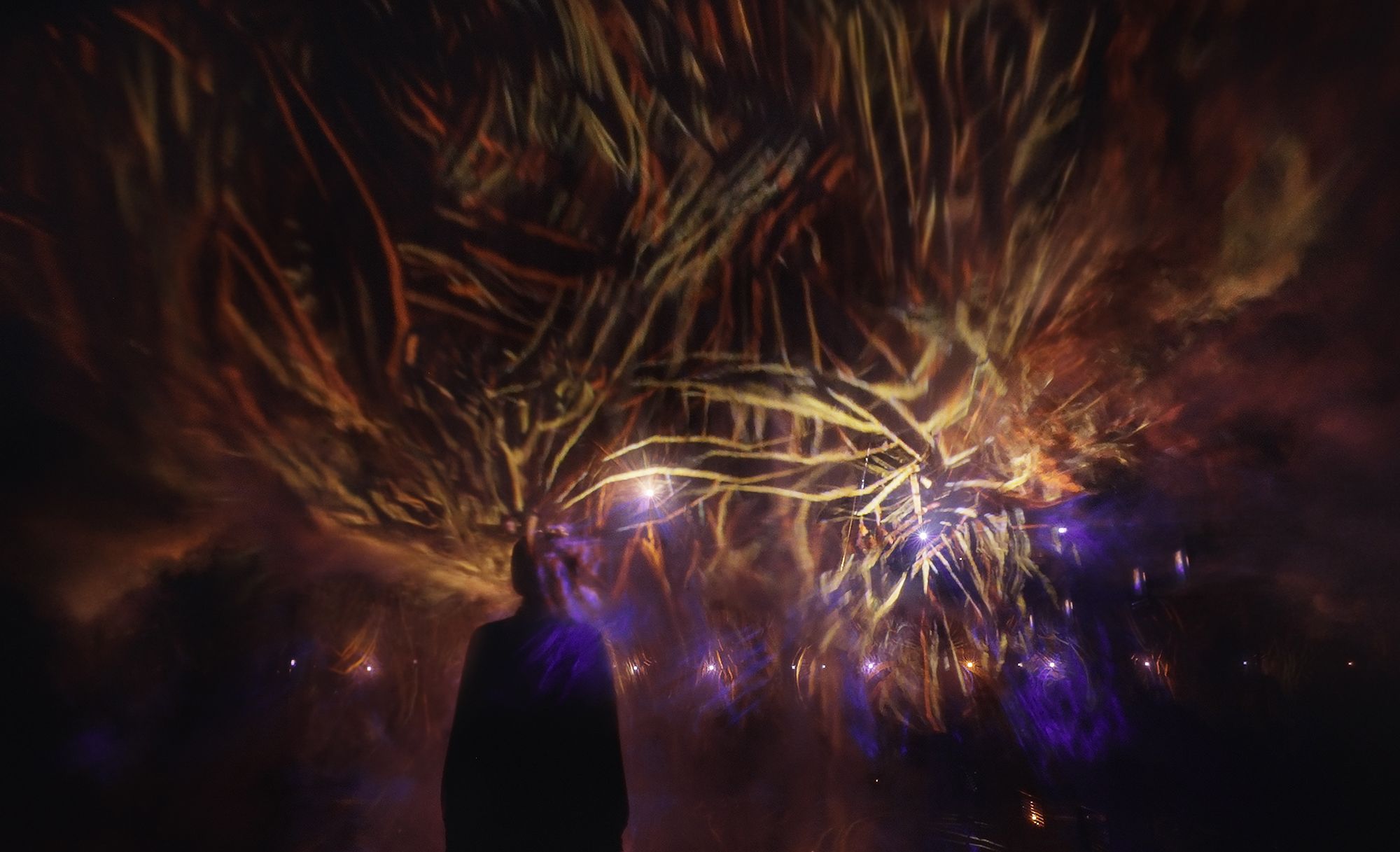
There may be no centerpiece at Borderless, but when another teamLab member, Sakurako Naka, opened a curtain to the new “Light Sculpture” series, she said the collective is “super excited” about this one. The room uses mirrored panels and lights that flicker, jolt and swerve in unison to create hypnotic vortices in three dimensions.
“It’s amazing, right?” said Kudo. “I’ve seen this one maybe 200 times and it never gets old.”
Achieving all this is no easy feat — and it’s one that Kudo credits to the spirit of collaboration among the multidisciplinary collective’s many members (teamLab does not say how many people it counts among its constantly-changing ranks).
“We can’t do it with technology alone,” added Kudo. “It’s about working together as a team to create art and change people’s perceptions. And maybe with that we can help change the world.”
[ad_2]
Source link
[ad_1]
Welcome to Best of Late Night, a rundown of the previous night’s highlights that lets you sleep — and lets us get paid to watch comedy. Here are the 50 best movies on Netflix right now.
The Nevada presidential primaries took place on Tuesday, with Nikki Haley as the only candidate listed on the Republican ballot.
Stephen Colbert called the primary “a big chance for her to spark some Nikk-mania,” but Haley came through with only 30 percent of the vote, losing to the option “None of these candidates.”
“Yep, Tucker Carlson interviewing Vladimir Putin may not be, uh, mean much to you, but for Trump, this is like watching OnlyFans.” — JIMMY FALLON
“Vladimir Putin — he’s a murderer, he’s a war criminal, he hates America, he hates everything America stands for, he’s a liar and a propagandist, but Tuck thinks we just need to hear him out.” — JIMMY KIMMEL
On Wednesday’s “Jimmy Kimmel Live,” the creator and star of “Abbott Elementary,” Quinta Brunson, responded to Daniel Radcliffe’s saying they could be a good “height match” for a romantic comedy film.
Mariska Hargitay will celebrate 25 years of “Law & Order: SVU” on Thursday’s “Tonight Show.”
[ad_2]
Source link
[ad_1]
Times Insider explains who we are and what we do and delivers behind-the-scenes insights into how our journalism comes together.
Zachary Woolfe grew up in a musical household. His parents were big fans of Bob Dylan and Joni Mitchell, and often played their music throughout their Long Island, N.Y., home.
So when he, as a teenager, hung a picture of the dramatic soprano Birgit Nilsson above his bed, they were supportive, he said, if a bit confused.
“I was a serious cellist from elementary school through high school,” said Mr. Woolfe, 39, the classical music critic for The New York Times. He began taking private lessons when he was about 9 and played in all-county and all-Long Island orchestras, and his love of the genre has only grown.
Now, 13 years into a career as a music critic at The Times — he began as a freelance critic in 2011 — Mr. Woolfe has carved out a niche among classical music critics. His goal is to make the genre accessible to readers new to the art form, as well as interesting to aficionados who may be attending their 25th performance of Mahler’s Fifth Symphony.
“I think what people are interested in is passion,” Mr. Woolfe said. “Even if you didn’t understand every word, my goal is for you to be drawn into my pieces because you can tell that I really care about what I’m writing about.”
In a recent phone conversation, shortly before he attended a performance by the Boston Symphony Orchestra at New York City’s Carnegie Hall, Mr. Woolfe reflected on the importance of covering classical music across the globe and the future of the genre. These are edited excerpts from the conversation.
When did you first become interested in opera?
Not long after I started playing the cello, I heard a clip from “La Bohème” on Encarta, the Microsoft CD-ROM encyclopedia. I was stunned. I asked my grandparents, who lived in Manhattan, “Can we go to the opera?” So my first opera was “Bohème” at the Metropolitan Opera in December 1995, when I was 11. I was drawn to the whole spectacle of it.
How many nights a week do you typically attend performances?
It really depends on the week — this week, for instance, I’m going to Carnegie Hall two evenings in a row to review performances by the Boston Symphony. A few weeks ago, I was covering Prototype, which is this contemporary opera and musical theater festival. I went to five or six performances that week. And I try to see shows I’m not reviewing as well — as much as I have the energy for.
In the past year, you’ve written articles from more than half a dozen cities around the world, including Berlin; Chicago; Salzburg, Austria. Do you find it important to cover performances outside New York?
We want to present the full range of classical music to our readership, which means we need to cover the institutions, personalities and composers that we feel are worthwhile around the world, not just in New York. Last year, I spent a week in Tbilisi, Georgia, with one of the world’s greatest opera singers who had been struggling with vocal problems over the last few years. That article just wouldn’t have been as vivid if I wasn’t there with her.
How do you balance writing for readers who may be less familiar with classical music and those who are more knowledgeable?
It’s a constant work in progress: how to make everyone feel like an article was written with them in mind. You want experts to be able to glean something, and for the neophytes to feel challenged, but not left in the dark or talked down to. And that comes down to choices about how to describe things and how much insider language to use, like “diminuendo” or “staccato.”
I’m always absorbed by the lively language of your reviews. How do you accomplish that?
There are always lazy, easy ways I could convey something, but I want to push myself and think of the more vivid, visceral, interesting comparison. I have tried to work on conveying more of what things feel like to me, not just what they sounded like.
What do you think is the biggest challenge that classical music will face in the next 10 to 15 years?
With costs spiraling and revenues pretty static, the viability of the big opera company and the large symphony orchestra continues to be in question. For me to say “There will always be music” is true, but it’s also glib, because there are certain things that large, tenured, unionized symphony orchestras and large opera companies can do that otherwise can’t be done or that you wouldn’t want to hear another way.
What do you wish readers knew about you?
It makes me super happy when there’s disagreement about my reviews. I do not aspire to them being universally agreed with. I enjoy the conversation. But hopefully there’s a sense that I’m operating in good faith and with fairness, even if you disagree with the conclusion.
[ad_2]
Source link